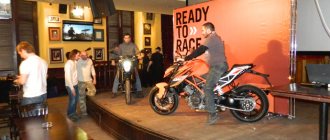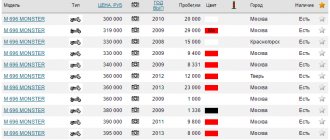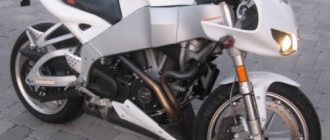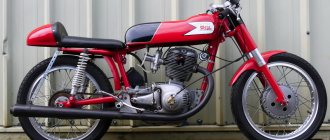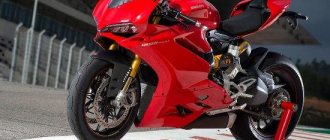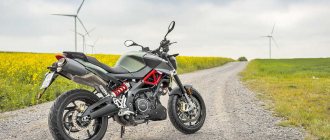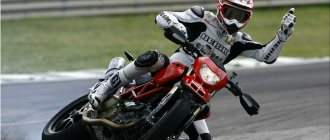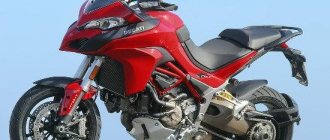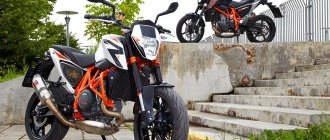Three from the casket
There is an opinion that Italian motorcycles are not reliable, unlike Japanese models. However, this judgment is most common among those who simply spare money for the purchase and maintenance of the Ducati 999. Here it is important to observe some subtleties, thanks to which you can enjoy a close acquaintance with this technique for a long time. Firstly, a Ducati motorcycle cannot be the only means of transportation, because “carrying someone’s butt to and from work every day” was not a primary goal even in the initial design stages. This technique is intended for the soul, for measured self-esteem, for sport in the end, but not for daily use. So, for example, with a mileage of 7 - 10 thousand kilometers per year and timely careful maintenance, the Ducati 999 will last for quite a long time. Secondly, Ducati needs to be felt in order to notice the slightest changes in behavior. Maintaining your equipment in good condition by contacting a professional in a timely manner will cost much less than repairing it.
A brilliant creation of Italian industry is not bought for one or two seasons, until the release of a new model - this is a long-term and very sensitive relationship. This is a kind of analogue of a monogamous marriage: new motorcycles, of course, are bought, but no one is going to say goodbye to the Ducati 999. Some 20 years will pass - and it will be possible to safely travel to elite collectors’ gatherings.
Test drive ApriliaRSV Mille 1000 R, Ducati999
All motorcycle lovers have heard and know about the unusual status and high prestige of the Ducati brand. At the same time, few people can clearly explain what is unusual and exclusive hidden under the fairing of the Italian motorcycle. I have been looking for the answer to this question for a very long time. I read articles about the advantages of a two-cylinder engine over a four-cylinder engine, articles about the advantages of the Ducati layout, compared technical characteristics... and did not find any convincing explanation for myself. The first signs of clarity on this issue appeared in my head when I started riding the ring. I rode an ordinary Japanese Kawasaki, and the shortcomings that were inherent in my motorcycle were theoretically absent from the Ducati. I received final confirmation of my thoughts on the day of this test, when we tried to find out what the thoroughbred Italians Aprilia RSV 1000R and Ducati 999 are like.
We decided to test two “Italians” with two-cylinder V-liter engines to get an impression of a) how big the “gap” is between them and the Japanese “fours”; b) how different they can be from each other. After all, both of these models are sportbikes in a “civilian” version, which means that they are a priori suitable for everyday driving and for going to the race track on weekends. After all, this is what thoughtful owners of “sports” do: they race on the track, and simply ride on the roads, enjoying not the speed, but the motorcycle itself.
Experienced riders know that power alone does not provide true riding pleasure. Real pleasure from a motorcycle can only be obtained when the chassis matches the engine, when the braking dynamics are adequate to the acceleration dynamics, when the ergonomics do not force you to think about yourself. A motorcycle can be powerful or not very powerful, small or large, asphalt or off-road, but, in any case, it must be harmonious, then you will like it. But still, engine power is the most attractive line in the technical characteristics table of any sportbike; it is sought with the eyes first of all. So let's look at the design of both motorcycles, starting with the engine.
The Aprilia power unit was developed with the assistance of Rotax specialists and has a magnesium crankcase, which in itself is not repeated by anyone else in the world. The two-cylinder engine with a cylinder angle of 60 degrees and four valves per cylinder, having evolved, was inherited from the previous generation of RSV. In 2006, it received valves of increased diameter and, accordingly, an exhaust manifold of increased cross-section. The newly reprogrammed fuel injection system now ensures exhaust purity according to Euro3 standards. The inertial charging system, with an air intake located in the center of the fairing between the headlights, adds another 3% of power at maximum speed. The two-cylinder V-twin engine by its nature generates strong vibration. Aprilia engineers wisely decided that they did not have a Harley (which holds vibrations in high esteem) and equipped the engine with a balancer shaft.
The Ducati 999 engine is also traditional, but with a camber angle of 90 degrees. An engine of this configuration has been installed on these motorcycles for many years, with the front cylinder lying horizontally and the rear cylinder, accordingly, standing strictly vertical. Therefore, this motor is most often called L-shaped. The traditional four valves per cylinder for modern engines are driven by an unconventional desmodromic mechanism. The essence of this mechanism is that the valves are opened by the camshaft, as usual, but they are closed by special cams, and not by springs. The advantage of this valve drive is precise adherence to valve timing: at high speeds there is no inertial hanging of the valves. Once upon a time, back on air-cooled carburetor engines, the desmodromic mechanism made it possible to do without a red zone on the tachometer, the engine was not afraid of over-torque, it simply lost power, and you were forced to change gears. Modern Ducatis traditionally have no redline, but this is deceiving, the electronic rev limiter still kicks in at 10,500 rpm.
The Ducati frame is so original that it has already become a kind of calling card of the company. Welded from chrome-molybdenum steel, the spatial structure has not changed its appearance for many years, although it is constantly being improved. The Aprilia frame is more modern, it is assembled from cast aluminum elements. The front forks of both motorcycles have the same diameter of the moving pipes, equal to 43 millimeters. The only difference is in the suppliers: while the Ducati has a Showa fork, the RSV has the iconic Ohlins as standard. The rear shock absorbers on both bikes are from Showa.
The brakes, of course, are from the world's best manufacturer, Brembo. The braking mechanisms are almost the same on both motorcycles, the only difference being that on the Aprilia they have a radial caliper mount, and on the Ducati they have an “old-fashioned” traditional one. Even the rims on both cars are of a similar design and were made by the Italian wheel couturier Marchesini.
All these technical nuances and design features actually say nothing about how these motorcycles ride and why they are loved or not loved.
For the first time in my life, when I rode a Ducati, I also had a passenger on my back! An interesting feeling: I couldn’t drive away from a traffic light normally. I take off smoothly, but as soon as the tachometer needle reaches 3000 rpm, the motorcycle “goats up”, I have to close the gas and engage the next gear. But even in the next gear he is happy to goat when the engine spins up to 5 thousand. It is clear that the passenger loading the rear is in the way, but this is a real manifestation of the notorious “traction from the very bottom.” The next time I went for the test. I was riding alone, and since such a motorcycle needs to be tested on a track, my path lay through the entire city, to “Chaika”. When driving around the city, a very pleasant moment for both “twos” (in Ducati this factor is more pronounced) is that the motorcycle is narrow and its ability to “climb” between cars is the same as that of another moped.
The dynamics are like those of a motorcycle. What motorcycle? It is impossible to answer this question unequivocally. It seems that the slightly boosted Japanese 600 drives just like this liter Italian. Ducati's dynamics cannot be compared with any GSX-R1000 or Yamaha R1. He pulls, but doesn’t lift his hands, there is no explosive character at all. The L-shaped two has softened reactions to gas operation and the engine does not provoke jerking and mischief as sharply as the Japanese “liter”. Of course, if you get on this motorcycle after the 400 or after the Java, you will be amazed by its dynamics. But if after the Japanese “liter”, then if you try the standard “999th”, you will most likely be disappointed. But what will really fascinate you is the chassis. The motorcycle is incredibly stable both on asphalt waves and on cracks. The stability and stability of the motorcycle is the same as that of a sports motorcycle with stiff springs and clamped shock absorbers, but when driving through potholes, the energy intensity of the suspension is so good that there is no smell of any super-hard “cond” at all. What's really hard is the seat and clutch lever. The clutch is equipped with a hydraulic drive, and still, after twenty minutes of “squeezing” around the city, two fingers of the left hand are no longer able to squeeze the lever; you have to work with four fingers, and this is unpleasant.
What about Aprilia? The seating position is a little more civil, the clip-ons are higher, the seat is softer. If you don’t know what kind of motorcycle you’re riding, it’s impossible to tell the “fifth point” difference in the operation of the suspensions of these two motorcycles. But the clutch is no longer so tight. In general, the bike from Noale gives more comfort, but as a compatriot and ideological ally, it has a character similar to Ducati. The engine also pulls smoothly and confidently after 2 thousand, just like Ducati, power increases with increasing speed. The operating range of the engine is similar. In general, if you close your eyes to the “little things”, then for the driver these are two absolutely identical engines. The minor differences in this case are sound and vibration. The Ducati sound is a combination of a tricky valve train and a loud dry clutch. Anyone can listen to the sound of a working Dukat clutch at home. You just need to take an old Soviet alarm clock and ask it to ring: the same measured, metallic clang is made by an Italian mechanism worth 20 thousand “cu.” Aprilia, equipped with a “wet” clutch and a traditional valve drive, does not make unusual sounds.
What is the advantage of a two-cylinder motorcycle over an inline four-cylinder? Firstly, the motorcycle is noticeably narrower, and this is a significant advantage for daily use in a large city. It’s easier to “sneak through” traffic jams. When turning, it does not trace the asphalt with plastic. The four-cylinder doesn’t seem to work either, but this is achieved by the fact that the engine is located higher in the frame. Therefore, a narrow motorcycle is easier to control, and this is immediately noticeable (and pleasant!), even in city driving mode. Secondly, the two-cylinder engine has a small crankshaft. And the crankshaft is a very massive part that retains inertia well, that is, a gyroscope, which prevents the motorcycle from quickly turning into a turn. The smaller the size and weight of the gyroscope, the easier it is to shift the motorcycle. Thirdly, a less “revving” engine with a smoothly increasing power allows you to start opening the gas earlier in a turn and more accurately control the beginning of the moment the drive wheel stalls. Each layout has its own “highlights”, but instead of an in-depth study of the theory, it is still much more interesting to find out whether these theoretical advantages can be experienced in real track conditions.
Once you drive around the ring for the first time, everything becomes clear. Ducati is a motorcycle sharply tailored for sport. It was originally designed as a sports equipment and it is not for nothing that it won so many championship titles in the WSBK championship. Every detail, which in the city still raised doubts about convenience, on the ring proved the justification of its use. The large dial tachometer is in the peripheral vision zone, and the speedometer, located behind the tachometer, closer to the tank, is no longer in the field of view. In the city, in order to find out about the speed, you had to take your eyes off the road, but the fact is that on the roundabout this is unnecessary, so they removed the unnecessary information “out of sight.” The narrow tank, with its bizarre shape, demonstrates the wonders of ergonomics. All manufacturers have more or less convenient knee pads, but this is the first time I’ve come across a tank molded to fit the forearm! When you move in a deep bend, hanging down, your elbow finds such comfortable support on the tank that it allows you to completely relax your arm. And when braking at the end of the straight, you need to try to relax your hands as much as possible and not lean on the steering wheel. How to do this if you somehow need to control yourself on a motorcycle? On Ducati this question does not arise. You need to squeeze the tank with your feet, and there will be a frame under your knees, you can rest against it and completely relieve the steering wheel from the load. How to relax your hands when accelerating and not grab the steering wheel? On the Ducati, the closely spaced rear seat step creates a great butt support!
The performance of the chassis is unique. An uneven section of the track, where I had difficulty holding the gas open on my Kawasaki ZX-10R (at the same time, the steering wheel was torn out of my hands, and with the damper tightened, the whole motorcycle was already thrown), the Ducati passes as if the asphalt had been re-laid there! You can drive at full throttle while holding the steering wheel with one hand! The motorcycle does not jump, the steering wheel does not break out of your hands, you ride and relax. What is the secret of such stable behavior? Framed? In a suspension? I thought this was a unique character, unique to Ducati, until I rode the Aprilia, which turns out to behave in the same noble way! The behavior is absolutely identical, although it has an aluminum diagonal frame instead of a steel “birdcage” and a different fork. Braking is equally good on both motorcycles. I slowed down and went into the turn. Kneeling tilt is also easy to achieve, but on the Ducati you feel a little more confident in turns, and you can tilt the motorcycle as quickly as you like. This pair is more pleasant and easier to drive than other 600s. Motorcycles that you can ride out of the showroom without adjusting anything and ride on standard tires around the ring (moreover, easily and confidently) are worthy of admiration. At the exit of the turn, while still leaning, I add gas, add, add... I expect the wheel to slip and... nothing happens. The acceleration on the slope increases, but the wheel doesn’t even think about slipping! Lap after lap I accelerate at the exits more and more aggressively. It got to the point where I felt the throttle stick! It seems unrealistic that you can give full throttle while still in a turn, in third gear, and a liter motorcycle, without slipping, “unfolds” the trajectory and accelerates to the exit. The gears are short by “liter” standards: as soon as you level off, tuck in the next one. I approach the turn, brake, and with a shift in the throttle I fall one step lower. It’s impossible to drive the entire circle in one gear, like in a Japanese “liter”. This is not surprising: for two-cylinder engines, the cutoff is triggered at around 10,000 rpm, and for “fours” there are still about 3 thousand revolutions left, and you can continue to “turn” the engine without switching.
What surprised me most was not the Ducati's exemplary handling; that's what I expected. I was surprised that the Aprilia, despite all the external differences, rides very similar to the Ducati. Its only difference is in its more civil ergonomics. If you need a motorcycle that can show “299” on the speedometer on the country highway, then neither one nor the other “Italian” will suit you. These are motorcycles for those who appreciate a superbly tuned chassis, not a crazy engine. But for the sake of such a chassis, it is quite possible to sacrifice a dozen or two “km/h” of maximum speed. For those who do not want to ride up to 280 km/h, and need to see the number “300”, the more powerful Ducati 999 in the “R” version and the Aprilia RSV1000R in the Factory version are offered. Although this is primitive: buy a motorcycle that wins the World Championship, and use it only for racing in a straight line. As for the differences from the Japanese “in the ranks”, in absolute terms the “Italians” are definitely inferior. You ask: “How do they tear apart everyone and everything in WSBK?” And thanks to the incredible balance of chassis and engine! These motorcycles require knowing how to take advantage of their advantages and turn their perceived disadvantages to your advantage. If you have them, you will be invincible, because the truth is that it is not always in the “horses”, brother...
Text: Valery Garbaruk
Photo: michel
The legend of "far away"
It's funny, but the developers of Ducati were people who initially had nothing to do with motorcycles. So, one of them tried to design a boat motor, the second was engaged in the production of musical instruments, and the company of the Ducati brothers at that time was successfully engaged in the manufacture of radio equipment. After the start of joint cooperation in the post-war years, a decision was made to create motorcycle equipment - this is how the debut Cruiser model, equipped with a 175 cc horizontal overhead valve engine, an electric starter and - the most amazing thing! — automatic gearbox. However, this motorcycle was not destined to win the hearts of the Italians, while models with a smaller cubic capacity were more in demand.
In the year of its debut (2001), no one understood Ducati. The majority simply lamented the fact that the new 999 is not at all similar to its predecessor (916). It turns out that Pierre Terblanche was able to get ahead of his time - after all, only in 2007 the shape and design of the Ducati began to be perceived as a high-quality and well-calibrated mainstream, the headlights no longer seem too miniature, and the sharp edges and side panels do not cut the eye.
Ducati 999: technical specifications
This is a permanent favorite among the fastest bikes. The desmodromic drive in Ducati engines makes it possible to remove operating restrictions; it is for this reason that the red sector of absolutely unnecessary revolutions cannot be seen on the tachometer. Engine power is checked in the most precise way - all measurements are made at the rear wheel, and not at the crankshaft. The modern Ducati motorcycle is a bike designed for brutal and dynamic riding. Thanks to desmodromic valve timing, the two-cylinder engine easily produces 140 horsepower at the rear wheel. The engine capacity is 998 cubic meters, with maximum power achieved at 9750 rpm. Compared to previous models, the Ducati 999 has significantly increased torque.
Where to look for a car and why?
Surprisingly, but true: on the secondary market you can find a fairly large amount of information about the sale of Ducati 999. At the same time, the price does not deter: the cost of the “far away” is on par with similar models of sports motorcycles. Used motorcycles are most often imported from America or Japan, much less often from Europe. Officially, Ducatis are also sold in Russia, and finding a bike with a clear history is quite possible. In general, it is best to look for a good motorcycle on sites and forums where true Ducati connoisseurs live - here there are much more opportunities to purchase a bike that has previously been serviced by an experienced mechanic, which means the condition of the motorcycle will be quite satisfactory.
Why should you buy such a motorcycle? Using it purely for “rides” and as a vehicle is blasphemy. The race track is where the Ducati shines. Of course, we should not forget about those events that are intended to demonstrate such “toys”.
A connoisseur's dream. Part 1
Oh, these Italian girls, cars, motorcycles (underline as appropriate)! You know how to excite the blood better than any illegal drugs. Whatever you say, when it comes to technical beauty and grace, Italy has been and remains a recognized authority.
This is because things made with soul bear the imprint of the essence of their creator. Italians don't know how to make non-sports motorcycles! Whatever they do, they always end up with a sportbike in different guises. Needless to say, with the targeted production of racing equipment, they manage to outdo all existing motorcycle manufacturers over and over again.
Within the framework of this material, we will deliberately narrow the circle precisely to those models that can still actually be found in the vastness of Russia. In the first part of the article, we will look at early-generation motorcycles produced until 2006.
The history of Ducati sports motorcycles goes back more than 60 years. The era of the legendary two-cylinder Italian engines started in 1971 with the release of the Ducati 750 GT from the pen of Fabio Taglioni. This motorcycle, born in the process of numerous engineering experiments, set the rhythm of the company’s development for many years and largely determined its fate and racing victories. The list of more or less current Ducati sports motorcycles, which are already on the verge of antique condition, but are still found alive in the hands of motorcycle enthusiasts, begins with the “851” model. This purely racing motorcycle served as the beginning for the more civilian modification “888” (“three eights”), which already at that time (1991–1993) sported an inverted fork and an injector. Its 888 cm³ liquid engine is the progenitor of the super-successful Ducati 916 model, with which we want to start the material.
Win at any cost
"916" (1993–1998)
In 1994, Ducati released a truly masterpiece of power, appeal and racing technology, which was rightly called the best motorcycle of the decade. Its name is Ducati 916. This device, already in its standard version, was ready to force the opponents of that time to fight on the track. The brilliant designer Massimo Tamburini had a hand in creating the legend. Around the L-shaped two-cylinder engine (the L-type, due to the larger cylinder angle compared to V-type engines, has the advantage of higher torque) with a volume of 916 cm³ with desmodromic valve drive and a peak power of 114 hp. With. the ideal sports motorcycle was created at that time. All technologies used come directly from the world of motorcycle racing. Dry clutch is not a whim or marketing in this case. This system allows the driver, even with completely destroyed clutches, to reach the pits and not destroy the engine (remember the legendary saying “kill the clutch, kill the engine,” well, it doesn’t work here). The friction force of a dry clutch is much higher than that of a clutch in an oil bath; it also eliminates the possibility of oil burning on the driven discs during microslippage in severe conditions or inexperienced use. Desmodrome initially made it possible to combat valve lag at high speeds. Fabio Taglioni, being obsessed with racing, tried to create an engine that could spin faster than its competitors, without fear of consequences. Springs and valves of that time were not as technologically advanced as they are now. The weight of the valves and the stiffness of the springs did not make it possible to close the valves at high speeds, and they remained slightly open for some fractions of a second, even if the camshaft cam was turned to an angle that gave a large valve clearance. The likelihood that the piston in this situation was catching up with the hanging valves was very high! As the speed increased, a small clicking sound appeared (the result of the piston hitting the valve). If you close your eyes to this and continue to raise the speed, the force of the piston impact will bend the valve and subsequently break off its plate. At the same time, the inertial force of the entire motorcycle and the running engine, transmitted along the drive chain through the gearbox, encountering an obstacle in its path (the valve between the piston and the cylinder head), seemed to explode the engine from the inside, causing catastrophic damage to it and depriving the rider of the opportunity to continue the race. Initially, the use of desmodrome was a brilliant move by Fabio Taglioni in the fight for supremacy on the racing tracks, and later it became the calling card of Ducati.
The exhaust system, hidden under the seat, has a positive effect on reducing aerodynamic drag and improving weight distribution. The suspension features a powerful, fully adjustable fork at the front and a cantilever swingarm at the rear, which saves significant time when changing wheels in racing. The power unit is housed in an incredibly strong and rigid birdcage frame made of chrome-molybdenum tubing.
Since its debut, in less than eight years, more than 50,000 copies have been successfully sold (including the smaller Ducati 748). The main guarantee of successful sales, of course, was victories on the race tracks. The three Ducati sisters 916, 996 and 998 once dictated their terms to the whole world, winning six World Superbike titles.
The appearance of the motorcycle turned out to be surprisingly laconic. Fans associate it with Italian Ferrari cars of the mid-90s. To this day, this timeless design literally attracts crowds of fans, forming a certain layer of motorcycle enthusiasts who buy the 916 and its later modifications simply because they cannot take their eyes off them!
Despite their purely sporting purpose, Ducati sports models up to the “998” were produced in both the single-seat Strada version and the two-seat Biposto version. All subsequent civilian models began to be equipped with a special plug for the passenger part of the seat as an option.
Which is surprising, especially for those who themselves have never ridden early Ducati sportbikes and judge motorcycles purely from the stories of friends and forums, “916”, “748”, “996”, “998”, “999” and “749” simple and extremely reliable devices (of course, no one has canceled their venerable age), in which, thanks to the gentle degree of forcing and extreme thoughtfulness, there is nothing particularly broken. The main thing is timely maintenance, and this should be special for sports equipment. Those owners who understand this live with their two-wheeled pets in peace and harmony for many years. It is difficult to kill an engine; it has three crankshaft main bearings on rolling bearings. An increased appetite for oil usually does not occur even in seasoned specimens.
Don’t feed the Italians spaghetti, just let them release more special versions of their motorcycles. This is especially true for sportbikes. In addition to the countless number of image modifications (Senna, Foggy Replica, etc.), which are of little interest from a technical point of view and mostly differ purely cosmetically, almost every model has a couple of charged versions, which differ greatly in technology and, in fact, are intermediate step towards the next basic version.
From 1994 to 1996, the 916 SP (Sport Production) was produced. This is practically the same motorcycle that Carl Fogarty himself rode on race tracks. Differences from the standard equipment include an adjustable steering column, a more powerful engine, increased maximum power and Ohlins components.
Even longer than the basic 916, the 916 SP Special version was produced (1997–2000). Its specificity lies in the increased engine volume (cylinder diameter increased to 98 mm, becoming 2 mm larger than the standard engine with a volume of 916 cm3). Sports camshafts and larger valves were installed, and a new exhaust system was tuned to provide more maximum power (123 hp) at 9800 rpm. This motorcycle is the progenitor of the “996”.
"748" (1994–2002)
The 748 is nothing more than a smaller copy of the 916, created to counteract the Japanese 600 sportbikes in the Super Sport championship. The motorcycles are similar in everything except engine size and wheel sizes. The frame, suspension and brake system parts were exactly the same as on the older version.
On later 748s (since 2000), instead of three-spoke wheels, they became five-spoke and more angular. This innovation immediately spread to other models. In the same year, on most motorcycles, the quick-release plastic fasteners were replaced with regular civilian ones. In motorcycles 2001–2002 there is insufficient quality control and, as a result, a large number of manufacturing defects where there should not be (crankshaft, frames, rear progression rods, etc.).
The angry version of the 748S (1995–2003) differs from the basic one in an adjustable steering column and Marchesini wheels (appeared on all models since 1999). The top version was the 748R (2000–2003), which was an almost ready-made racing machine. The bike was equipped with a 996 frame, adjustable steering column, Showa suspension, Marchesini wheels, an air filter and larger valves, a completely updated injection system with nozzles located deep inside the air filter, aimed precisely at the huge 54 mm throttle valves. Due to pistons with a higher bottom, the compression ratio was increased. Power increased to 106 hp. With. at 11000 rpm. By 2001, the 748R had been upgraded once again, with the frame again updated and an Ohlins fork and monoshock installed.
"996" (1999–2001)
Ducati 996 is another intermediate step in the model line, which does not carry significant upgrades. Compared to the previous model, the fuel supply system has been improved and the generator power has been increased. Of course, due to an increase in the cylinder diameter by 2 mm, the volume increased to 996 cm³. The chassis remains the same with the exception of new, more powerful Brembo calipers. There are no external differences from the 916.
Interestingly, this bottle-green motorcycle will forever go down in history as the war horse Trinity from the film “The Matrix.” The heroine, completely dressed in latex, did things on camera that even the craziest stuntrider would not dare to do. Although, in truth, most of this episode was made using computer graphics.
Towards the end of its release in 2001, engineers decided to cheer up the 996 a little by releasing three different special versions. The basic one differed from last year only in the presence of an Ohlins rear shock absorber. The 996S was equipped with the 996SPS engine producing 123 hp. s., Ohlins rear monoshock absorber and Showa fork. The 996R was released in a limited edition of 500 pieces. The motorcycle had a Testastretta engine (135 hp at 10,200 rpm), Ohlins suspension and, in fact, was the progenitor of the 998.
"998" (2002–2003)
The Ducati 998 is a transitional model that was produced for only a year, mainly to test the new Testastretta engine in the old chassis before launching a completely new generation into series. Purely visually, the “998” can be distinguished from its predecessors by the absence of two air intakes on the plastic in the area of the sticker with the model name. The 998R (2002–2003) was equipped with the second generation Testastretta engine (139 hp at 10,000 rpm), which featured a shorter piston stroke, and Ohlins suspensions.
"999" (2003–2006)
Ducati 999 (aka “three nines”) logically should have been called 998 (due to the engine capacity of 998 cm³), but such an index was already taken. The new model had to be artificially renamed.
The motorcycle turned out to be structurally extremely successful and balanced. However, seasoned Ducatists did not immediately properly perceive it due to the significantly changed design and the transition to a less technologically advanced pendulum in the rear suspension. The Ducati 999 is indeed visually very different from its predecessors. The side plastic received new, more swollen contours, the front optics now consist of two round headlights located one above the other, the tail unit became flatter and more openwork, and the instrument panel acquired a liquid crystal screen and a completely non-canonical arrangement of the main indicators.
In terms of engine performance, the “999” was inferior to all its classmates. The “L-shape”, of course, won back a slight advantage due to its confident traction at the bottom, but this was not enough to fight the faster “row” vehicles.
One of the main problems of this device is the overrunning clutches that quickly fail due to the strong acceleration of the engines. They often do not nurse even 10,000–15,000 km. As soon as the starter starts to slip, you shouldn’t fiddle with it any further; it’s better to immediately tackle the repair, otherwise it may break some adjacent parts. Replacement work costs about 3,500 rubles, the cost of parts per set starts from 15,000 rubles. In the “999” model, the manufacturing defects have finally disappeared.
The 999S modification is distinguished by a single seat, different brain firmware, Ohlins suspension and an adjustable steering column. The 999R is much more equipped. It has forged wheels, front brake calipers with radial mounting and a motor rebuilt down to the cog (150 hp at 10,800 rpm), which has a very modest resource. The chassis boasts a height-adjustable pendulum mount.
"749" (2003–2006)
According to an established tradition, the company's most iconic models are duplicated in smaller copies. For the “three nines”, the “749” model became such a continuation. The motorcycle is equipped with a 748 cc version of the Testastretta engine, producing 108 hp. With. The chassis and appearance are unified with the “999”, with the exception of the wheel size. All the main technical goodies flowed from the older brother - an asymmetrical exhaust system with pipes of different sizes, a digital data exchange system between the electronic instrument panel and the ignition/fuel injection system control unit, which reduces the number of wires and sensors, and a steering damper as standard equipment. The Dark version is distinguished by a matte black color. The top modification is the 749R. A large number of improvements have been made to its design - the piston stroke has been reduced and the cylinder diameter has been increased, the valves have been enlarged, the fuel tank has grown to 18.3 liters, a slipper clutch and Ohlins components have been installed, carbon and magnesium are among the materials. The 749S version differs from the basic one by an adjustable steering column and simplified Ohlins components. Not bad for a smaller copy!
Crash tests
Classic models, from "916" to "749", are famous for their increased durability. To cause serious damage to them, you must try to break all existing laws of physics. In moderate falls, mirrors are usually shot off but not broken, brake and clutch levers are bent, weights on the steering wheel are damaged, and plastic is scratched but not cracked. Also, sometimes the footrests bend and the glass headlight breaks. In some cases, driving a car almost right through is not a reason to return home using a tow truck.
Market and service
Motorcycles of the first generation are increasingly relegated to the rank of relic treasures, destined to be an adornment of a personal collection and only occasionally get out on the rough asphalt of racing tracks and public roads. All models, from the Ducati 916 to the Ducati 999, are found on the secondary market in small quantities, but with enviable regularity. Pricing is more than humane, if you do not take into account rare limited modifications. Naturally, as a driving unit, the most profitable purchase is the “three nines”, but the “916” and “996” are also in low but steady demand. The maintainability of these motorcycles is, of course, high, but truly competent servicemen can be counted on the fingers of one hand. Almost all routine operations are performed an order of magnitude faster than any competing sportbike. The openwork frame does not block access to vital components, and all plastic is attached to quick-release connections. By the way, for Ducati to this day, excessive simplicity in the manufacture of plastic is considered the norm, which can be expressed in slight misalignment and small discrepancies in the seats. The most difficult operation is adjusting the valves. Due to the high cost of spare parts and difficulties in finding qualified service, the costs of repairs and maintenance can exceed even the wildest expectations many times over.
Total
Whether we like it or not, the days of “analogue” motorcycles such as the Ducati 916, 748, 996, 998,999 and 749 are over and are not coming back. How can we not bring back those brilliant racing battles in which the greatest athletes showed the wonders of piloting without sophisticated auxiliary systems, relying equally on themselves and the motorcycle. And, despite the fact that even the most modern modifications of those years are already considered obsolete equipment on the market, every second motorcyclist among those who are interested in technology and understands a lot about it dreams of them.
To be continued…
We would like to express our gratitude to the Workshop of Evgeniy Zheludkov for their assistance in preparing the material, www.royal-mc.ru, tel. 8-916-087-82-77.
If you change in time, you will brake in time! >
Similar materials
A connoisseur's dream. Part 2
6 June 2014 10:24 Mikhail Pimus
Price
Prices for “far away” are quite reasonable. For example, on the secondary market you can easily find a good model, the cost of which will vary within the same limits as the price of a similar model of a sports motorcycle with the same characteristics, but from a different manufacturer.
It is worth noting that the price is not determined by the year of manufacture - it depends primarily on the condition of the motorcycle and its version. Nevertheless, it is possible to determine the average cost - a Ducati 999 produced in 2003-2005 will cost approximately 280-400 thousand rubles. Of course, this charisma and incredible power are worth it.
Ducati 999
The Ducati 999 replaced the 996 model in 2003 and, despite outstanding engineering solutions, did not repeat the success of its predecessor, largely due to its unique design. Let's try to understand what lies under the “shell” of the fairings and what the purchase and maintenance will entail.
STORY
In 2003, Ducati presented to the public a model with the index 999. The completely new motorcycle was strikingly different in appearance from its predecessor: the two elongated headlights on the sides of the fairing were replaced with vertically located lenses, the place of the cantilever pendulum was taken by a regular one, the spokes of the cast wheels acquired a Y-shape. The frame is the same birdcage, L-twin with desmodromic valve drive and dry clutch. The excellent engine is complemented by Showa suspension and excellent Brembo brakes with reinforced hoses. The steering column reach angle is adjustable from 23.5 to 24.5 degrees.
In 2005, the motorcycle was slightly updated: the side holes disappeared from the front fairing, and the swingarm became welded (from several aluminum elements).
Along with the regular 999, versions S and R were produced, and if the S version was distinguished by its “single-seater”, slightly different firmware of the “brains” and Ohlins suspensions against the “native” Showa, then in the R version it was a completely different motorcycle. Forged wheels, front brake calipers with radial mounting and a motor rebuilt down to the cog indicate the sporting purpose of the car and, as a result, a very modest service life of 200 hours. Among other things, the R version is distinguished by a height-adjustable pendulum mount (the holes for its mounts in the block and frame are oval). In the road versions there is no such adjustment (although there is still an oval groove milled on the frame where the pendulum is attached) - the hole drilled in the crankcase allows for the pendulum to be installed in only one position.
In 2006, the discontinued 999 was replaced by a new model with the index 1098.
WHERE TO LOOK?
There are plenty of offers on the secondary market: a lot of simple “far away” models in the S version; from time to time, motorcycles in the R version pop up for sale. Second-hand goods are brought mainly from America and Japan, where cars from Europe are less common. Officially, the 999s were also sold here, so finding a “white” device with a “transparent” history is quite possible. When searching through private advertisements, you should start by monitoring the sites of Ducati enthusiasts: there are more chances to buy a motorcycle with a good history, serviced by an experienced mechanic.
FOR WHAT?
Primarily for the track. There, the motorcycle’s potential is revealed to its fullest: excellent brakes, adjustable suspensions and ergonomics in general - everything is tailored for sports. In the city, you can also ride a narrow and relatively light motorcycle; the only thing that will cloud the picture is the exhausting work of the left lever on the handlebar: the clutch is dry. But it’s not worth driving out of the city: neither the sporty seating position nor the rigid suspension are suitable for long-range driving on our roads.
CHOICE
The motorcycle has no serious problems. The main thing is timely and high-quality service. You need to choose a 999 with a mechanic who works with Italians and knows how to listen to the engine.
The desmodromic valve drive in a motorcycle does not cause any particular problems, but the clearances must be monitored and, if necessary, adjusted approximately once every 10 thousand km. Like valves, timing belts require careful attention: every 5 thousand km - check the tension and, if necessary, adjustment, every 10 thousand - replacement. If the belt is not tight enough, it can cause it to jump; if it is overtightened, it can lead to a break or premature death of the bearing of the “distributing” shaft. A break or slippage of the timing belt leads to engine destruction, and the death of the bearing leads to oil leakage through the oil seal (drips are visible from under the timing belt casing). In any case, after purchase, the belts need to be changed, preferably in the “correct” service center.
A dry clutch of “three nines” is a consumable: it doesn’t take much time for the friction discs and their seating areas in the “basket” to break. Experienced users change discs every 5 thousand km, the “basket” every 10 - this is the price for the trouble-free operation of the mechanism. By the way, it is better to replace both the “basket” and the wheels not with the original, but with a higher quality aftermarket one, which is sometimes cheaper.
The 999's engine doesn't handle wheelies well: oil is taken from the middle of the sump; when driving on the rear wheel, the oil flows down, exposing the oil pump tube, which leads to oil starvation. This problem was partially solved on 999s produced after 2005 - there is an oil trap in the pan. In any case, the sound of the scrolled liners will outshine even a badly damaged clutch, so it won’t be difficult to hear an extraneous ringing.
If there is a strong fall on the left side of the “three nines”, the thrust of the gearbox selector drum is deformed, which makes it difficult to engage gears. The part is inexpensive, and it is easy for an experienced mechanic to replace it.
TUNING
There is probably no part in the Far Away that cannot be replaced with an aftermarket one. There is everything on sale: from unusual gas caps to carbon rims and even crankcases. The tuning list is limited only by the budget and needs of the user.
For everyday use, the first step is to replace the clutch slave cylinder with a tuning one, with an increased piston diameter - it will significantly reduce the force on the lever and add comfort. There are a lot of offers, budget from 150 to 300 euros.
Sliders will help protect the motorcycle during falls, but there is a nuance here: often the sliders, which are screwed through the frame and engine, take the impact and transfer excessive loads to the “ears” of the crankcase mounting, breaking them off. The problem is solved by installing “remote” sliders through special milled brackets, for example from GSG-Mototechnik (7 thousand rubles). The fork and swingarm will be protected by sliders of the front and rear axles; a kit from the same manufacturer will cost 4 thousand rubles.
For “rides” on the track, a sport forward flow and a “zero resistance” filter will be useful, and racing “brains”, the range of which, as well as the price range, are huge: from 600 to 6000 dollars will help to really “irritate” the engine.
Carbon rims, a set of which will cost 4.5-5 thousand dollars, will help improve the motorcycle's handling, as well as acceleration and braking dynamics. The original driven sprocket will not fit the new wheel; it is better to order a suitable one along with the wheels.
